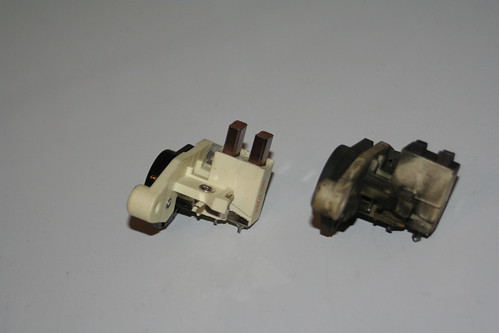On a Thursday evening the dash indicator lights started flickering while I was braking. The next day, as I was driving home, the radio started going in and out, and the blinkers were having a hard time clicking, the dash lights faded; the car became plagued by a host of electrical issues in a short time. I had just pulled off the highway in a residential street and the car died suddenly; no sputtering, no jerking, the engine just shut off.
I came back two hours later and – surprise! – I was able to start the car and drive (without headlights, to conserve the battery charge) the few remaining blocks to my house where it died again, just as I pulled into the garage.
Considering that the car had shut off while driving, when the alternator should supply all power, and that it started later again on battery alone, I was pretty certain this was an alternator problem not a battery problem.
The question was how to I tell whether this was caused a broken alternator or a broken voltage regulator. The two components work together: the alternator produces the current that powers the car and recharges the battery when the engine runs, while the voltage regulator controls the field current that activates the electromagnets located on the rotor inside the alternator. If the alternator fails there is no current to power the car’s electric components and recharge the battery. If the voltage regulator breaks, it may fail to limit the current generated by the alternator and melt the battery or it won’t apply current to the rotor’s electromagnets, which in turn won’t generate current when the rotor spins (the beauty of 10th grade physics…) Many things can go wrong with this system. Here’s a link to a more detailed technical description: http://www.familycar.com/Classroom/charging.htm
Tests that indicate which component has failed exist but you’d have to start with a fully charged battery, and mine was dead (it measured 11.3V, which is as good as dead). The flickering of the dash lights usually indicates that the brushes of the voltage regulator, which supply the current that magnetizes the alternator rotor on contact with the rotor’s slip rings, have worn out and make intermittent contact. Replacing the voltage regulator is an easy job on the Bosch alternators used in E30 cars; the VR is mounted on the back of the alternator with two screws. The regulator can be replaced without removing the alternator. The battery must be disconnected first.
I decided to replace the voltage regulator and assumed the alternator was still good; it was unlikely that both would fail at the same time. Besides, the VR is much easier to replace that the alternator and cheaper too: only $20 at PelicanPart.com, whereas a rebuilt alternator can cost up to $200.
It turned out my assumption was correct; the voltage regulator brushes had worn down. The brushes were 3 and 4 mm in length, respectively; the shorter of them was covered with black soot. The VR should be replaced when the brushes are down to 5mm length.
Here’s a photo of the new and old parts, side by side.
My alternator may not be feeling very well either. I checked the voltage at the battery while the engine was revved up to 1500 RPM and it didn’t exceed 13.6V; it should go up to 14.5V. This is probably a sign that one of the alternator’s internal circuits is broken or burned; the whole thing is getting close to the end of its useful life. Here’s a new project to think of soon.




